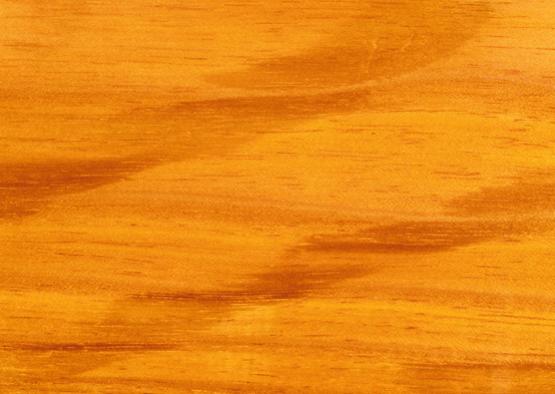Silver wattle is a timber of choice for furniture designers because of its attractive figure and ready workability. It affords a striking visual contrast to blackwood, a closely related species.

Silver wattle occurs throughout eucalypt forests and woodlands in New South Wales, Victoria and Tasmania. It is a fast-growing species that can reach heights of around 30 metres and a stem diameter of up to 75 centimetres. Because silver wattle has a relatively short lifespan and regenerates well after fire, supplies are usually readily available from stands of regrowth harvested on rotation.
This species yields a striking light brown to subtle pink timber with a straight grain and porous even texture. Silver wattle’s distinctive growth rings create an appealing and attractive figure; a striped pattern often results on back-sawn surfaces. It is a timber of choice among furniture designers and manufacturers, by whom it is often used in decorative counterpoint to blackwood, a closely related more common and much darker hardwood timber.
Silver wattle is easy to work with both machine and hand tools. It may be turned, bored, sawed and planed with excellent results. Pre-drilling is recommended when nailing, in order to prevent splitting. Silver wattle is an excellent bending timber. It glues satisfactorily with most common adhesives, accepts most finishes readily, and may be polished to a smooth, lustrous surface.
Silver wattle is not recommended for external applications, but is sufficiently durable for most internal applications including decorative, architectural and structural use. The untreated sapwood of this species is susceptible to lyctid borer attack.
Shrinkage
| Very Low | Low | Medium | High | Very High | |
|---|---|---|---|---|---|

|

|

|
|||
Tangential : |
6.00%
|
||||
Radial : |
2.00%
|
||||
Unit Movement Tangential: |
0.34%
|
||||
Unit Movement Radial: |
0.17%
|
Strength Group

Very High |
High |
Reasonably High |
Medium High |
Medium |
Reasonably Low |
Low |
Very Low |
||
Unseasoned: |
S1 |
S2 |
S3 |
S4 |
S5 |
S6 |
S7 |
S8 |
|
|---|---|---|---|---|---|---|---|---|---|
 |
|||||||||
Seasoned: |
SD1 |
SD2 |
SD3 |
SD4 |
SD5 |
SD6 |
SD7 |
SD8 |
|
 |
Stress Grade

| Structural No. 1 |
Structural No. 2 |
Structural No. 3 |
Structural No. 4 |
Structural No. 5 |
|
Unseasoned: |
F14 |
F11 |
F8 |
F7 |
F5 |
Seasoned: |
F14 |
F11 |
F8 |
F7 |
F5 |
Density per Standard

Seasoned: |
710kg/m3
|
|---|---|
Unseasoned: |
800kg/m3
|
Joint Group

Very High |
High |
Reasonably High |
Medium |
Low |
Very Low |
|
Unseasoned: |
J1 |
J2 |
J3 |
J4 |
J5 |
J6 |
|---|---|---|---|---|---|---|
 |
||||||
Seasoned: |
JD1 |
JD2 |
JD3 |
JD4 |
JD5 |
JD6 |
 |
Colour

| White, yellow, pale straw to light brown | Pink to pink brown | Light to dark red | Brown, chocolate, mottled or streaky | |
 |
||||
Mechanical Properties
Modulus of Rupture - Unseasoned: |
68
|
|---|---|
Modulus of Rupture - Seasoned: |
87
|
Modulus of Elasticity - Unseasoned: |
10.5
|
Modulus of Elasticity - Seasoned: |
11.4
|
Maximum Crushing Strength - Unseasoned:  |
31
|
Maximum Crushing Strength - Seasoned: |
54
|
Impact - Unseasoned: |
14
|
Impact - Seasoned: |
19
|
Toughness - Unseasoned: |
Medium - 15 - 24 Nm
|
Toughness - Seasoned: |
Medium - 15 - 24 Nm
|
Hardness - Unseasoned: |
4.0
|
Hardness - Seasoned: |
5.1
|
Durability
| Low | Moderate | Reasonably High | High | |
| (0 - 5 yrs) | (5 - 15 yrs) | (15 - 25 yrs) | (more than 25 yrs) | |
In-Ground: |
||||
| (0 - 7 yrs) | (7 - 15 yrs) | (15 - 40 yrs) | (More than 40 yrs) | |
Above ground: |
||||
| (0 - 20 yrs, usually < 5) | (21 - 40 yrs) | (41 - 64 yrs) | (More than 60 yrs) | |
Marine Borer Resistance: |
Lyctid Borer Susceptibility: |
|
|---|---|
Lyctid Borer Susceptibility - Other: |
|
Termite Resistance: |
Fire Properties
Critical Radiance Flux - Lower: |
>2.2 and <4.5 |
|---|---|
Critical Radiance Flux - Higher: |
≥4.5 |
Smoke Development Rate: |
<750
|
| 1 - non-combustible | 2 - reasonably non-combustible | 3 - slightly combustible | 4 - combustible | |
Fire Properties Group |
Average Specific Extinction Area: |
<250
|
|---|---|
Bushfire Resistance: |
BAL 12.5 and 19 – All AS3959 required applications
|
Silver wattle is a striking light brown to subtle pink timber with a straight grain and porous even texture. Silver wattle’s distinctive growth rings create an appealing and attractive figure, especially on backsawn surfaces, where a striped pattern often ensues.
Silver wattle is a timber of choice for furniture designers and manufacturers. It is often used in counterpoint to blackwood, a closely related but much darker hardwood species. It is suitable for most internal applications, including structural, architectural and decorative.
Silver wattle is easy to work with both machine and hand tools. It may be turned, bored, sawed and planed with excellent results. Pre-drilling is recommended when nailing, in order to prevent splitting. Silver wattle is also an excellent bending timber. It glues satisfactorily with most common adhesives, accepts most finishes readily and may be polished to a smooth, lustrous surface.
Allied Forest Products

Briggs Veneers Pty Ltd

Forest Strategy Pty Ltd

Matilda Veneer

Ridgewood Timber Pty Ltd

